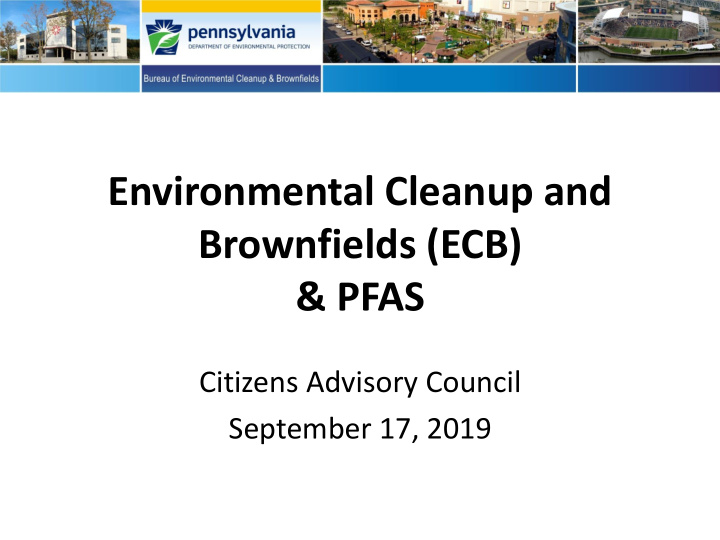



Environmental Cleanup and Brownfields (ECB) & PFAS Citizens Advisory Council September 17, 2019
What are PFAS? • Per- and polyfluoroalkyl substances (PFAS) – Family of more than 3,000 chemicals – Manmade chemicals manufactured and used in thousands of processes and products since the 1940s • Became popular because they repel oil and water, are temperature-resistant, and reduce friction • The most-studied substances are perfluorooctanoic acid (PFOA) and perfluorooctane sulfonate (PFOS)
Where are they found? • Found in soil, air and water, and break down slowly in the environment • Firefighting foams • Stain-repellant clothing, carpets, upholstery; household products, such as non-stick cookware, polishes, waxes, and food packaging • Metal plating and wire manufacturing • Only certain compounds have been phased out
How do people become exposed? • Contaminated drinking water Such contamination is typically localized to a specific facility; such as an industrial facility where these chemicals were produced/used to manufacture products, or areas used for firefighting training.
Why does it matter? • Bioaccumulate in the body • There is evidence that exposure to PFOA and PFOS can lead to adverse human health effects.
What are the impacts from PFOA and PFOS? • Studies show that PFOA and PFOS can cause reproductive and developmental, liver and kidney, and immunological effects in laboratory animals, including: – Increased cholesterol levels – Low infant birth weights – Effects on the immune system – Cancer – Thyroid hormone disruption
ECB’s Role • Land Recycling (Brownfields) – Voluntary cleanup program (Act 2), soil and groundwater remediation standards • Site Remediation – State & Federal Superfund, Storage Tank Corrective Action, DoD • Storage Tanks – AST and UST technical standards, certified tank installers and inspectors, registration, permitting and inspections 7
Challenges • Current regulatory status • Lack of approved analytical methods • Risk of cross contamination • Limited lab capacity • High analytical costs 8
Challenges • Very little toxicity information • Lack of standards • Evolving remedial technologies • Limited disposal and treatment options 9
Remediation Standards • EPA Maximum Contaminant Level (MCL) or Lifetime Health of Level (HAL) = Act 2 Statewide Health Standard • Combined EPA Lifetime HAL / Act 2 standard for PFOA/PFOS is 70 ng/L • Proposing soil and/or groundwater Medium Specific Concentrations for PFOA/PFOS and PFBS 10
National Foam Act 2 Site, Chester County • Manufactured fire- fighting foam from the 1940’s to 2016 at 2 acre site in West Chester Borough • Entered Act 2 program in 2015 • VOC’s, SVOC’s and heavy metals in soil • PFAS compounds in soil and groundwater • PFAS compounds detected in nearby Goose Creek • Characterization activities are ongoing 11
Ridge Run HSCA Site, Bucks County • Public water supply contained concentrations of PFOA/PFOS > 70 ng/L. • Another public supply well was found to contain combined concentrations slightly below 70 ng/L • DEP took immediate steps to investigate the surrounding area 12
Ridge Run HSCA Site, Bucks County • DEP sampled 170 private wells in the vicinity of the contaminated public supply wells. • 13 properties with concentrations > 70 ng/L are equipped with carbon filtration systems or receiving bottled water. • DEP’s efforts to characterize the extent of contamination and to identify a responsible party is ongoing 13
HSCF Revenue • Capital Stock and Franchise Tax (exp. 12/2015) - $40 million • Act 13 Transfers (start 2014) - $19 million • Hazardous Waste Fees - $1.7 million • Penalties, Interest, Cost Recovery - $3 million 14
HSCF Status/Projection Hazardous Sites Cleanup Fund in thousands Fund Balance Revenue Expenditures $80,000 $70,000 $60,000 $50,000 $40,000 $30,000 $20,000 $10,000 $0 15
Troy Conrad, Director Bureau of Environmental Cleanup & Brownfields tconrad@pa.gov 717-783-9480
Recommend
More recommend